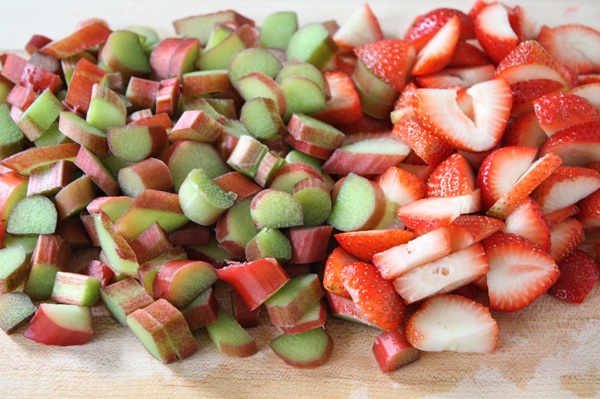Sweet and Savory Apricots
/
Apricot Honey Jam
4 pounds or so fresh, ripe apricots (visit your local coop or farmers market)
½ teaspoon each: cinnamon and cardamom powder
Pinch salt
6 Tablespoons local honey
Start by blanching and de-stoning the apricots. Bring a large pot of water to a boil. Fill a bowl with cold water. Drop the apricots into boiling water and boil for 20 seconds. Transfer to the ice water with a slotted spoon, and cool briefly. Slip off the skins, cut in half and remove the stones.
Place the apricots and spices in a heavy saucepan and simmer for 15 minutes over medium heat. Simmer 10 to 15 minutes, stirring often, until the apricots have broken down into a Stir often until the apricots have reduced into a thick purée.
While jam is cooking, sterilize pint mason jars and lids by placing them in the sink, pouring boiling water over them, and draining them on a clean dish towel.
Separate oven racks so that a jar fits in between them and line the racks with cookie sheets. Preheat oven to 200 degrees.
Add honey and stir to incorporate. Taste for sweetness and add more honey if desired. Turn off heat and ladle hot jam into hot jars. Make sure you leave 5 cm of headspace from the top of the jar.
Remove air bubbles and adjust headspace as needed. Wipe any jam off of jar rims and put lids on jars. Screw bands down until tight.
Turn off the oven. Place jars in oven and leave them in for 6 hours or so.
Test jars by pressing on the top to make sure that the lid is firm. Repeat the oven canning process for any lids that are not firm. Label jars with name and date, place on pantry shelves. Enjoy with grilled local trout, on breakfast toast, or with pancakes.
Apricot Tart with Local Wheat
inspired by a traditional recipe for hamantaschen
For the crust, mix the following ingredients together:
2 cups New Mexico whole wheat flour (from Butterworks Farm perhaps!)
2 Tablespoons apple cider vinegar
½ cup local butter, cut into squares (save the wrapper to grease your pie dish)
1 egg
Mix all ingredients together and add a splash of water of needed. Dough needs to be firm enough that you can pick it up with your hands and shape it into a flat disc. Wrap it in waxed paper and place it in the fridge to rest for 15 minutes.
Take 1 pound ripe, fresh apricots and slice each one in half. Remove the stones. Place halves in a bowl and toss with:
Juice from ½ lemon
1 teaspoon vanilla extract
1 teaspoon cardamom powder
Pinch salt
5 Tablespoons local honey
Set aside.
Preheat the oven to 350 degrees.
Grease a 9 inch cake or pie pan with the wrapper from your stick of butter.
Remove dough from fridge and roll it out between two sheets of waxed paper.
Spread dough evenly into the bottom and along the sides of a 9 inch round pie or cake pan.
Arrange apricot halves in layers, cut side down, on the pie crust.
Using the same bowl in which you mixed the apricots, mix together:
1 cup whole wheat flour
¼ cup vegetable oil
2 teaspoons cinnamon
Pinch salt
Leave this batter clumpy and use your fingers to sprinkle it over the top of the apricots to make a crumble topping. Bake for 1 hour, or until a knife inserted into the center tests clean.
Mediterranean Wheat Berry Apricot Pilaf
Boil 2 cups water in a medium stock pot.
Take 1 cup local wheat berries, rinse well, and pour into the boiling water.
Turn off the heat, cover, and set aside for ½ hour or so. This will tenderize the berries and reduce their cooking time.
Meanwhile, slice 6 ripe, fresh apricots in half and remove their stones.
Dice them into fingernail-sized cubes.
Place them in a bowl and toss them with 4 Tablespoons olive oil and 1 Tablespoon apple cider vinegar.
Mince 2 cloves garlic and 1 small shallot. Add these to the bowl.
Wash one bunch fresh, tender green kale. Chop coarsely and add to the bowl. Set aside.
Then, drain any remaining water and rinse wheat berries through a fine mesh strainer.
Return berries to stock pot, add 2 cups water, and bring to a boil.
Add 2 Tablespoons each: salt, lavender, tarragon, and rosemary.
Reduce heat to medium and simmer, with lid askew, for 20 minutes,
Add the apricots, garlic, shallots and kale. Stir briefly to incorporate and cook for 10 more minutes, or
until there is no water left at the bottom.
Enjoy with scrambled eggs for breakfast or local beans for dinner.















































